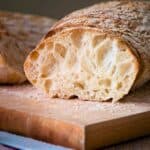Ciabatta Bread Recipe
Light, porous and airy on the inside, crusty and golden brown on the outside ciabatta bread is all about flavor and texture.
Servings: 3 loaves
Calories: 1098kcal
Ingredients
For starter
- 1 cup water (lukewarm)
- 2 cups bread flour , 260 grams (measured after sifting)
- 1 teaspoon dry yeast
For the dough
- 2 cups water lukewarm
- 5-6 cups bread flour , 650-750 grams (measured after sifting)
- 1 ½ teaspoon salt
For greasing
- 1 tablespoon extra virgin olive oil
Instructions
- In a medium size bowl add water and dry yeast. Wait 10 minutes until the yeast is fully dissolved and has a “creamy’ texture.
- Mix in the flour. You should get a very loose and sticky dough. It should have consistency thick enough not to come off from the spoon as, say, sour cream or greek yogurt, but wet enough so that it’s impossible to knead it by hand.
- Cover the bowl with a plastic wrap and let the dough rest at a room temperature for 3-4 hrs or overnight. I just don’t recommend leaving the starter for more than 24 hrs as the yeast will start to over-mature and lose its power.
- Once the starter is rested it will become bubbly and might become even looser when you left it. Now pour lukewarm water in the bowl, going around the edges of the bowl and pouring small portions at a time. This is how we hydrate and aerate the starter even more at the same time liberating it from the bowl.
- Pour the starter and water mix into a bowl of a standing mixer, oil the dough hook. Turn on your mixer on low speed, knead for a 1-2 minutes and start adding flour.
- In the last portion of flour (approx 1 cup) add salt and mix it into the flour. Add to the dough.Knead on medium speed for 10 minutes. You’ll notice the dough starting changing its texture, becoming more smooth and starting to climb up the hook. Increase the mixer speed to high and knead for another 10 minutes. If you mixer bowl is large enough you’ll see the dough coming off the bowl sides. That’s a perfect sign the dough is ready and has developed strong gluten. You would be able to tell just from the look that it’s very silky and shiny.
- Transfer the dough to a big oiled bowl, so that there is enough space for the bread to double or triple.Cover with plastic wrap and let it rise at a room temperature for about 40-50 minutes.
- After the first 40-50 minutes the dough will double in size. Deep a silicon spatula in a water and start folding the dough onto itself, from the outside to the center of the bowl. You should be able to make 6-10 folds.Do it gently, so that the dough becomes well aerated and not deflated.Now using both hands, rise the dough from the bowl letting it fold, turn the bowl 90 degrees and fold in the same manner again. Cover with plastic wrap and let rise for another 40-50 minutes.
- Repeat this last folding process once again and let the dough rest for the last 40-50 minutes.
- Once it’s perfectly bubbly and screams to get out of the bowl, GENEROUSLY sprinkle the working surface with the flour. You’ll regret if you wouldn’t. The dough is very sticky, but that’s the secret for gorgeous light and airy ciabatta bread.
- Flip the bowl upside down and let the dough “slide” off of the bowl by itself.
- Sprinkle your scrapers and top of the dough with flour again.
Constantly assisting with the scrapers give it a rectangular shape. Cut into elongated loaves or individual rolls. You can make the rolls either square or triangle and they are HEAVEN for panini. - Generously sprinkle linen cloth with flour and using large dough scrapers transfer the bread loaves onto it.
Separate each loaf with a towel fold (see the pictures) or use individual towel for each of the loaves. - Turn on the oven to 450F while ciabatta bread rests on the towel.
- After 10-15 minutes flip ciabatta loaves over on parchment paper sprinkled with semolina or corn flour (to prevent bread from sticking).
- Just before you put the bread into the oven, spray ciabatta loaves using a spray bottle with cold water to create steam. It helps the bread cook perfectly both on the inside and outside.
- Bake ciabatta for 20-25 minutes without EVER opening the oven. After 10 minutes in the oven reduce the heat to 400F.
When it’s golden brown, or may seem even slightly burned that is it.
Your ciabatta bread has just reached its perfection and all you have left is let it cool for 15-20 on the wire rack.
Video
Notes
For this recipe measure flour AFTER sifting.
Nutritional information is for one large ciabatta loaf.
Nutrition
Calories: 1098kcal | Carbohydrates: 212g | Protein: 35g | Fat: 10g | Saturated Fat: 1g | Polyunsaturated Fat: 3g | Monounsaturated Fat: 4g | Sodium: 1181mg | Potassium: 302mg | Fiber: 7g | Sugar: 1g | Vitamin A: 6IU | Vitamin C: 0.003mg | Calcium: 52mg | Iron: 3mg
